A day that ends in hope...
- José Fernández
- May 12
- 18 min read
Part 1: Diagnosis and Prescription
“We would like to save the tree.” He says this slowly, thoughtfully. I’ve just finished explaining what I think the next steps are for the tree in question.
I am talking to Michael Schlabach, a member of an Amish community in Belle Center, Ohio. A local arborist had met Michael at a funeral recently. They struck up a conversation and Michael had mentioned this tree. Jason Fairchild had shared my information with Michael to see if I could help. And now, here we are, standing in front of a sugar maple planted near the southwest corner of an Amish school house.
“I remember helping plant this tree when I was eight years old,” says Michael. “I’m fifty-three now, which makes the tree forty-five years old.”
I had mentally estimated the tree at 40-50 years old, so that gave me a little boost of confidence. I like when my impressions turn out to be right. Sometimes we can discover things by investigation and careful thought. Other times information just seems to rise up as a feeling, or a sixth sense. When that impression is confirmed, I feel like I’m on the right track.
Michael continued: “I noticed about five years ago that the tree had started to decline, to look weaker. Started seeing some dead branches up high and I’ve been looking for someone who could help find out what is wrong.”
The school house sits on a small rise on the north side of the road. This part of the country is mostly flat, open farmland. The sugar maple we are looking at is one of only two trees on the school property, which consists of the school house, restroom building, parking lot, perhaps another outbuilding, and a mowed field between the school house and the road.
Both trees are about the same age. The tree to the north shows more vigor, with the canopy density and twig elongation one would expect to see on a healthy tree that is still on the young side of life. The two trees are planted along the west side of the school house, providing afternoon shade to the structure and a shaded area for the playground.

Having the two trees helps. Both are the same species, planted in the same soil, at the same time. I have the luxury of speaking to a man who remembers the day the trees were planted. He told me how the trees were dug out of the woods and brought here to be planted. I realize then the importance of permanence, of steadiness and awareness of change over time, of being invested in caring for the land which one inhabits, because this is the land that one calls home. If I meet a client who has been on site for thirty years I feel fortunate. My job becomes easier because of the history they can share about the site. History that provides clues that can be applied to what a tree’s symptoms are trying to communicate. In this case, being able to talk to the person who planted the trees, played under them, and then continued to help care for the property which anchors the school where his own children have attended and perhaps their own children will soon attend is a new situation for me. As I do my work to see if I can help this tree, there is a deeper level of thought beginning to vibrate. But for now my work takes priority.
I show Michael how the tree to the north has a beautiful, nearly textbook flare at the base of the tree where the buttress roots are clearly visible above the soil grade. The sickly tree we are studying looks more like a telephone pole going straight into the soil. Visible at the surface are two roots that are coiling around the trunk, not yet applying pressure, but if the tree survives and continues to grow, eventually these roots will form a barrier against which the trunk will be constricted, causing a disruption in the function of vascular tissue in the trunk. I explain how there could be roots below the surface causing this problem already, contributing to the decline we are now seeing in the upper canopy.
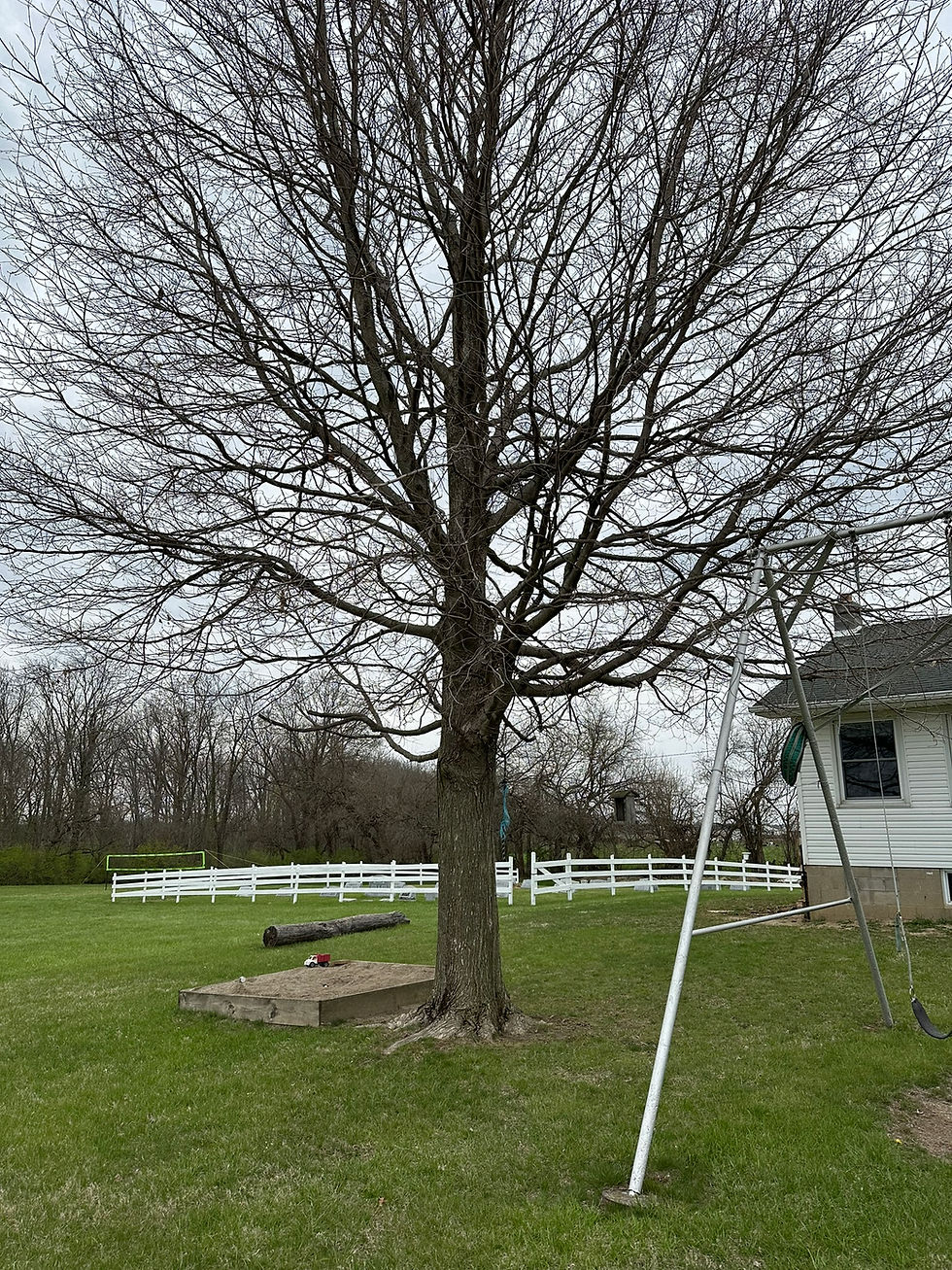
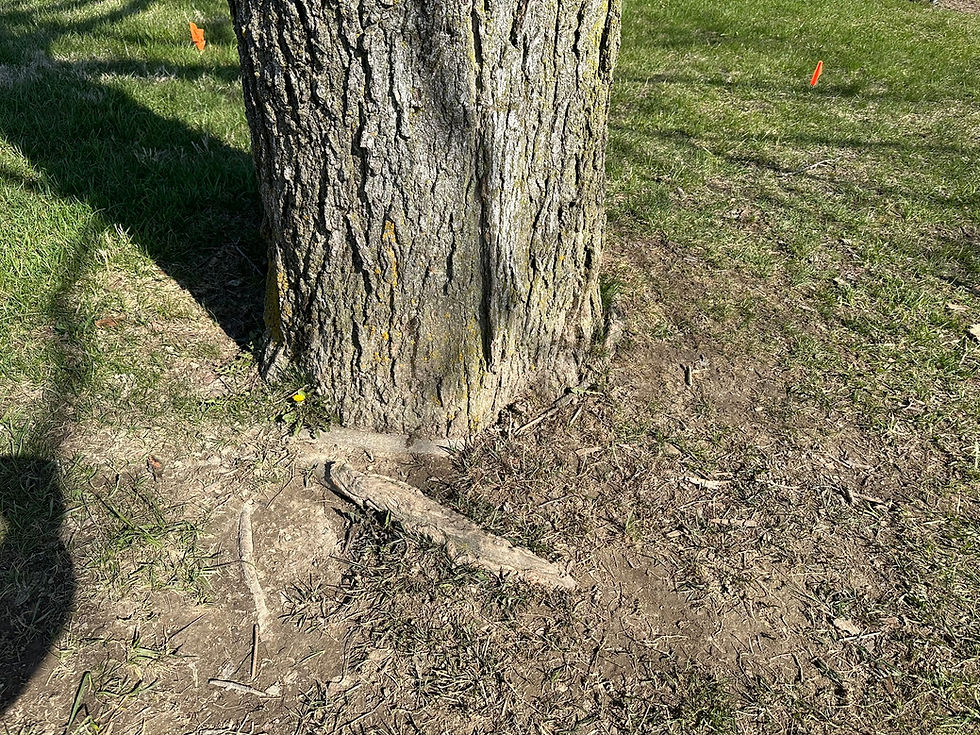
I also mention the possibility of verticillium wilt, a vascular wilt disease caused by a fungus that commonly attacks maple trees. I climbed the tree and cut out two recently dead branches, and did not find the telltale greenish/brownish blotching that would be a symptom of this disease. So my thoughts return to the physiological issue of girdling roots caused by the tree being planted too deeply.
There is also a great possibility of soil compaction, I explain. These two trees are the only source of shade, and the sickly tree is right up against the edge of the baseball field. I can see a track worn into the soil where foot traffic has worn the turf away. Even on a spring day with good soil moisture, the soil under my feet has a hardpan feel to it.
There is more to say.
Trees like to live in community with other trees. These are the only two trees in this area, and they were planted all by themselves. It would be helpful to surround the sickly tree with soil that is more like forest soil. There are fungi that live in forest soil which form associations with tree roots. There are other types of fungi which form associations with grass roots. I would like to make sure we are providing good habitat for the mycorrhizae we want to foster around the tree roots. To do so, we need to make sure the soil has air space mixed into it. We need to break open the compacted soil and add organic matter to help keep the soil open. Having space between soil particles will allow for air and moisture in the soil, as well as spaces for beneficial fungi and bacteria. We should top dress a good-sized area around the trunk with mulch to keep mowers away from the base of the tree. There is much more to say about this, but for the moment I only hit the high points.
Michael is following along. He has a ready smile, and asks good questions. Even though he is a cabinet maker, he loves trees and working outside. His father started the cabinet shop beside the school property, and it sounds like Michael has taken over the business.
While we are talking, a young man comes out of the school house and stands attentive to our conversation. I get the sense he is the school teacher, or somehow involved administratively.
To achieve my goals for the tree, I explain how I can use an air spade to remove soil around the tree trunk and try to expose the root flare. If I find girdling roots, I will prune them out if possible. Following that, I will use the air tool to break up and cultivate the soil four feet around the trunk, removing excess soil where possible. On top of this I will add compost and biochar, and then use the air tool again to mix all this up with the current soil. To finish it all off I will add a layer of mulch over everything. This will create an eight foot diameter cultivated mulch bed with a soil mixture perfect for air and water infiltration and space for living things like roots, bacteria, fungi, and small invertebrates to live in.
In addition, I would use the air spade to bore vertical holes in a grid pattern, 12-18 inches apart, 12-16 inches deep, under the remaining portion of the canopy out to the drip line. I would then fill these holes with the mixture of compost and biochar to help invigorate and aerate the entire soil area under the tree canopy.
Thinking out loud, I say “It would be great to have some local forest soil to mix in also, to try to bring in some mycorrhizae to establish in the new soil mixture.” Again that ready smile. Turns out Michael has his own compost pile, and he is happy to provide some soil he can dig out from the woods. Would I like to come over and see his compost pile to see if it would be suitable?
His house is right across the road.
That deeper vibration comes back. Michael Schlabach went to school in the very school house we are standing outside of. I now hear singing coming from inside. This reminds me of my own childhood school, and how we used to sing a prayer of thanksgiving to God every day before our lunch hour. I have not heard the sound of young voices coming from inside a wooden school house for longer than I can remember, and probably never as an adult.
Michael Schlabach lives in a house right across the street, and works right beside the school. He rides his bicycle to and fro.
The day is cool, and sunny. We are coming out of the first… well, the word is “correct” winter in Ohio we have had in years. We had a good extended period of cold weather with no false springs wreaking havoc on trees and flowers. Spring has also been long and slow, but not overly so. We have had great rainfall, but time in between to dry off a little.
Everything seems quiet today. There are no power lines stretching from the road to the buildings. Michael climbs into my truck so we can drive over to his house. We discuss some trees along his driveway. He wants me to check a couple of his own trees with some scale issues. We look at his orchard. “This is my therapy,” he says. Even Michael needs a hobby to find some peace.
The orchard is a step up from a hobby though. “Do you produce fruit to sell?” I ask. The smile shows up again.
“Well, I have lots of brothers and sisters, friends and neighbors.” He waves vaguely in the direction of other houses nearby. “We eat a lot of apples between us.”
We go into his ice house. He freezes water in buckets in the winter and then stacks the blocks of ice inside. This keeps the ice house cool all summer, around 35 degrees I think he said. He brings out a basket of apples from last fall and lets me pick out two. I munch on them as we look at the compost pile. It’s huge. “Yes, that will do. It will help if you bring over some of the finer stuff.” I add my apple cores to the compost pile.
I leave with a dozen fresh eggs.
As I pull out, I see a young man running like mad across the field in front of the school house. I realize there is a game of softball going on. Boys and girls together – the field is full of players. It looks like a lot of fun. It looks like another time in a different world.
_________________________________________________________________________________
Part 2: Treatment
Twenty-four days later my tools are all gathered up and I am on my way to Belle Center. I’ve just gotten onto the freeway when I realize I left my coveralls and my leaf blower. Air spade work is dirty work with soil flying all over the place, and into nooks and crannies of clothing. The next exit to turn around is a good ten miles away. For an instant I consider doing a U-turn across the median, but only for an instant. I can get by without my coveralls. Upon mentally reviewing the work site, I won’t need my leaf blower.
Another perfect spring day. Sunny and cool, no rain today. Enough moisture in the soil to make air spade work comfortable. Excavation with air in compacted soil that is dry can be an exercise in futility. That is not the case today.
Michael has set out a skid steer bucket full of compost and five large buckets full of beautiful forest soil. I lay out my tools near the tree and set up my compressor. I am not sure anyone is around so I peer into the school house door and see it is full of students. Everything is so quiet. I feel a bit guilty about the noise I will make with my operation.
Michael rolls up on his bicycle. He really wants to watch what I am doing, and even help, he says, but he has a client he is expecting, as well as some other things. He will check in on progress as he is able.
I’m about to get started when the school teacher comes out.
“The children will be let out for recess in two minutes. Is there any chance you can explain what you are doing? It will be a good learning opportunity for them.”
“Sure! No problem.”
“Did they tell you the story behind these trees?” he asked.
“Yes, Michael told me he had helped plant the trees 45 years ago, and they came out of the woods.”
“Well, when we were discussing the work you proposed at our meeting, we were told that this tree was the boys’ tree, and the other tree was the girls’ tree. The boys planted this one, and the girls the other one. We thought that maybe the boys dug a deeper hole.”
Fascinating. Amazing what history reveals. This absolutely makes sense. Two trees, same species, same size, same planting site. One, the girls’ tree, has a perfect root flare visible at the surface, what one would expect of a tree planted at the proper depth. The other has a buried root flare, placed into a deeper hole at time of planting. Either the boys were showing off, or more motivated during the digging. Or possibly the girls just decided they didn’t want to dig any further.
The students file out of the school house. About 20 or so students that seem to range from 8-15 or 16 years old or so, all very quiet and orderly, standing in a group, in line, facing me, boys on my left, girls on my right. It looks like they are posing for a group photo, and I realize I would like to have this photo. Perhaps I am thinking that way since I have taken photographs of the tree and the tree roots prior to work starting. I ask the school teacher if I could take a picture. He seemed hesitant, and said photos would be okay if the students were part of other pictures I was taking, but not posed photos. I felt a bit flustered, and realized it was an awkward request. I let him know I customarily take photos of my work as it progresses but that I would try to keep any people out of the photos.
After explaining my process to the students, I blew some soil away from the tree and exposed some roots. Right away they gathered around the tree and seemed very interested. Roots are pretty cool, I thought to myself. It is neat when all of a sudden you can see tree roots that were there all along, right under you, but you didn’t really know what they looked like. Arborists should do this more often as educational events.

I have blown soil off more trees than I can recall. I know an arborist who has done air spade work on a lot more trees than I have. When he and I talk about this I know he feels the same way I do: Even though we have done it over and over, there is still a thrill of discovery every time you do it. Each tree is different. Will the next one have a great root flare? Will it be bound up? Is that a root I can prune off? Sometimes a root that is severely girdling the trunk will release tension with a spring-loaded pop as soon as you cut it, and you can almost feel the tree sighing in relief like a rubber band has just been released after having been wrapped around its finger, or neck, for so long.
I explain to the students what I was seeing. “Is this what you expected to see?” asked the teacher.
“I don’t see any roots causing current problems. What we are seeing initially will cause future problems, but I’m hoping to find a current problem as that would point to a cause for the canopy decline we are seeing. There is a root here underneath these surface roots that seems to be going deeper and toward the trunk. Once I cut out these top roots I’ll continue excavating and see where that one goes.”
I had a bad feeling about that root.
The students went on to play and I went back to work.
Sure enough, I removed poorly growing roots and kept blowing soil away until I found the buttress roots of the tree, buried a good 6-8 inches below grade. I also found a large mass of roots severely girdled into the west side of the tree trunk and curling around the south and north sides of the tree, applying pressure all around. Whew! This was going to take some work. I brought out hammer, saw and chisel.
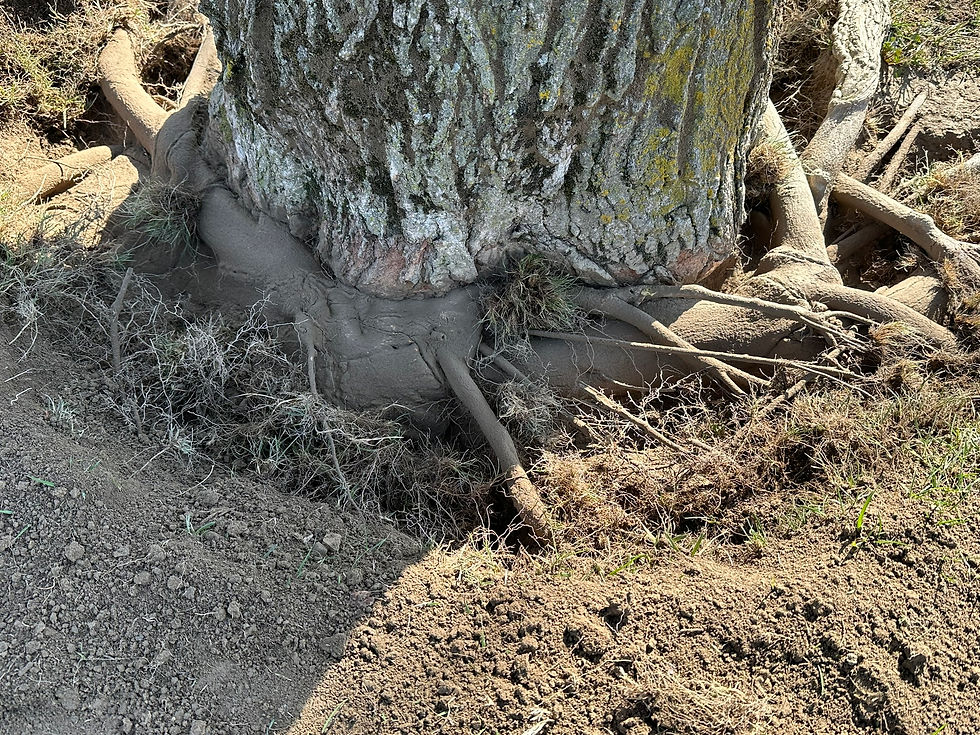
I was down to two remaining cuts when Michael came back. I showed him what I had found and what my goals were.
“Wow! I can see what you are saying! I never would have imagined that this was happening to the tree!”
Based on what we found and what I was able to do, I was pleased. There was a decent chance the tree would improve in health.
“You are doing a lot of work there. Did you find more than what you planned for?”
“Yeah, this is taking me more time than I thought, but sometimes that happens. You don’t really know what’s underground until you uncover it”.
“I see that. It’s like starting a remodeling job – you don’t really know what’s there until you get started.”
“Exactly. Good analogy”.

Root work done, I was finally able to start on the aeration. Soon after, the students all came out and started playing a softball game that lasted all afternoon. I found out later they were playing against some guests in preparation for a yearly picnic game where the youngsters play against the adults. I was able to listen and observe as I worked.
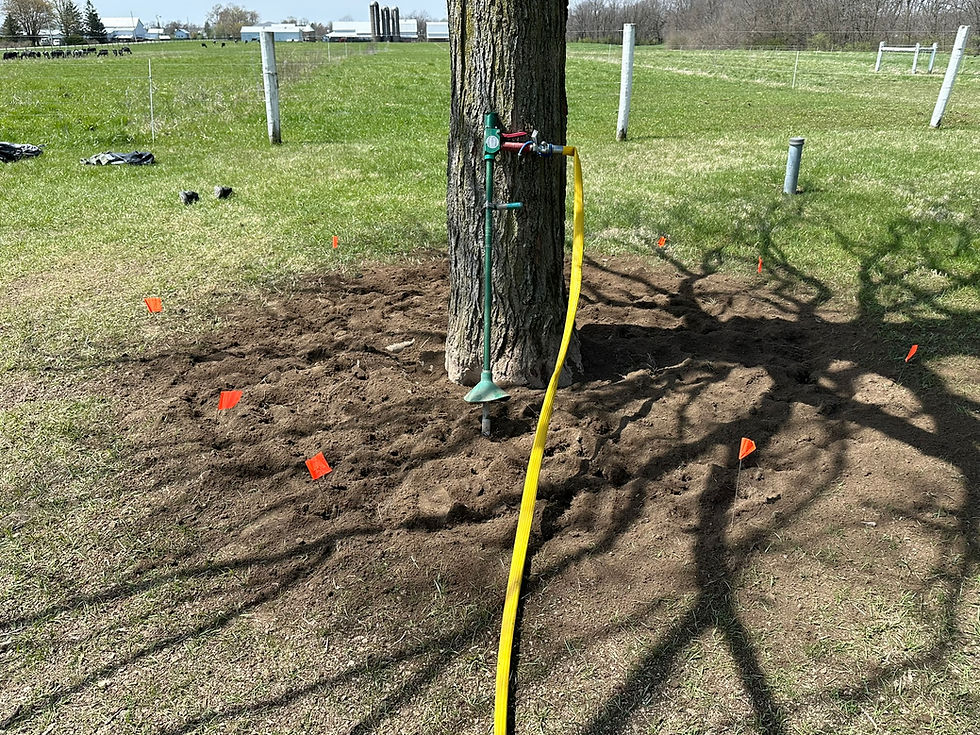

I have not been near a school playground recently, so I don’t know how this game was different from any other group of kids playing. What impressed me the most was how much fun everyone seemed to be having, girls and boys together. The girls were hitting and running as well as most of the boys. Some of the boys were making some impressive catches. Several of them had taken off their shoes, barefoot in the grass. The air was filled with all the sounds of people having fun at an afternoon softball game.
This didn’t really feel like the organized sports I have been around at public schools. And no one, not a single person, was tapping a phone or looking down at a phone in their hands. Everyone was smiling and … together. In some way, they seemed more together than I have seen people be in a long time.
The afternoon wore on, and the mulching was done. Michael had come back, and seemed to have some time now. I started with the final phase: vertical mulching.

After several minutes of watching, Michael asked me if there was anything he could do to help me. “Really, I would like to lend a hand if I could,” he insisted. I showed him how to mix up the soil the way I wanted and he started filling up the vertical mulching holes. A bit later the school teacher and a young lady came out and started filling holes as well. I didn’t pay much attention as I continued drilling holes under the tree. Finally that part was done and I could join in with the filling.
Michael and I started to talk and get to know each other as we worked together. His family moved down from Hartville and Berlin when he was a young child. He had pretty much been here his whole life. I told him about my family and where I was raised. We talked about being Amish, and how things were for them.
The afternoon was quiet, warm, and comfortable. We knelt on the ground, moving from hole to hole, filling our hands with soil, dropping life into the root zone. I saw a tiny centipede in my soil bucket. Beautiful…This soil is alive, I thought. Centipedes are predatory insects, which means there were other prey insects feeding on the decomposing organic matter, breaking it down further for microbial digestion to take place. These are all things tree roots need to thrive.
As we talked, the school teacher and the young lady listened. The school teacher commented from time to time. I filled holes. Michael was over by the soil pile, on his knees, mixing soil with bare hands and arms, working with it closely, unhurriedly. Then it was time for him to go.
The school teacher picked up the conversation. I asked their names. The teacher is Caleb Yoder. He came down from Michigan to marry one of Michael’s daughters. Janna Shlabach is another of Michael’s daughters who helps teach school.
We talked about books. They knew of my favorite writers: George MacDonald (Caleb recited a portion of one of his poems), Lewis, Tolkien, Chesterton. We talked about change in society, the worth and meaning of work. Mental work vs. manual work. How the two complement each other, and how both are needed.
I mentioned what drove me to start my own company prescribing and practicing arboriculture. How for the past fifteen years or so I had been strictly prescribing tree care by way of consultation, but not actually practicing tree care. How different it is now that I am back to practicing tree care and I feel so much more connected to my work and my purpose for being. “Here we are,” I said, “kneeling on the soil, our hands in the soil, doing work that so many people today would consider menial labor, fit for other people to do. And yet, this work connects us to the land in very important ways.”
I was thinking of comments made by Wendell Berry in one of his books I read recently called The Hidden Wound. Reading that book coincided with my taking up the practice of arboriculture once again, and sections of it resonated with my experiences so far. Some people gave me a funny look when I told them I was going to start my own company to do my own work. “You’re not going to have any employees?” they asked. In many ways, the direction I wanted to go was the reverse of where we are told we should go. We should be sitting at a desk, prescribing work for others to do. Actually doing the work is for someone else. Wendell Berry makes a powerful argument for damages caused to a person and to society and culture at large by this attitude. Granted, some work is knowledge-based, and needs to be. But when most work seen as desirable work is knowledge-based only, something is wrong. For starters, there is a danger of disconnection between the individual and the world we live in: the soil, the trees; plants and animals tended with respect.
In the past six weeks since I started working on my own, I have realized that if I have work to do, and the strength to do it, I will be at peace. In a way, life for me has slowed down a bit, and stress has nearly vanished. I still get telephone calls, but I manage those in a timely way into my work flow as I wish. I schedule my own appointments, of which there are not many, but so far, just enough. I meet with clients to consult, just as before, but then I go to do the work myself, which gives me full control over the final result. What I prescribe is what is provided.
While I am working, I am present in the moment, away from my telephone. The physical exertion of work provides its own set of benefits. I am no longer driving an average of 100 miles per day to consult with clients one after another, day after day.
Two days ago I mowed my lawn for the first time this season. I realized it was actually relaxing! It felt good to sit down and just mow after having been on my feet or in a climbing saddle all day. I used to dread sitting on the mower for an hour when I had been sitting in my car all day long. Now sitting down is restful, not workful.
Back at the school house, Caleb, Janna, and I filled the last hole. They said goodbye and left. The sun was much lower in the sky and there was some cloud cover now. It was around 5 pm. Long day, but very good day. All was quiet again, the school house closed. I was alone, loading up my tools. Everything ready, I took one last look at the sugar maple. The boys’ tree.
I walked over to it and stood under it. Please let this tree regain health and life because of the work we did here today, I asked. Please let it be here another 45 years, and even longer, and let there be such a community of people around it then as there is now.
If this prayer is answered, it will mean that many, many things have gone right. At the end of the day, working with trees is an act of faith, rooted in hope. A good end to a good day.
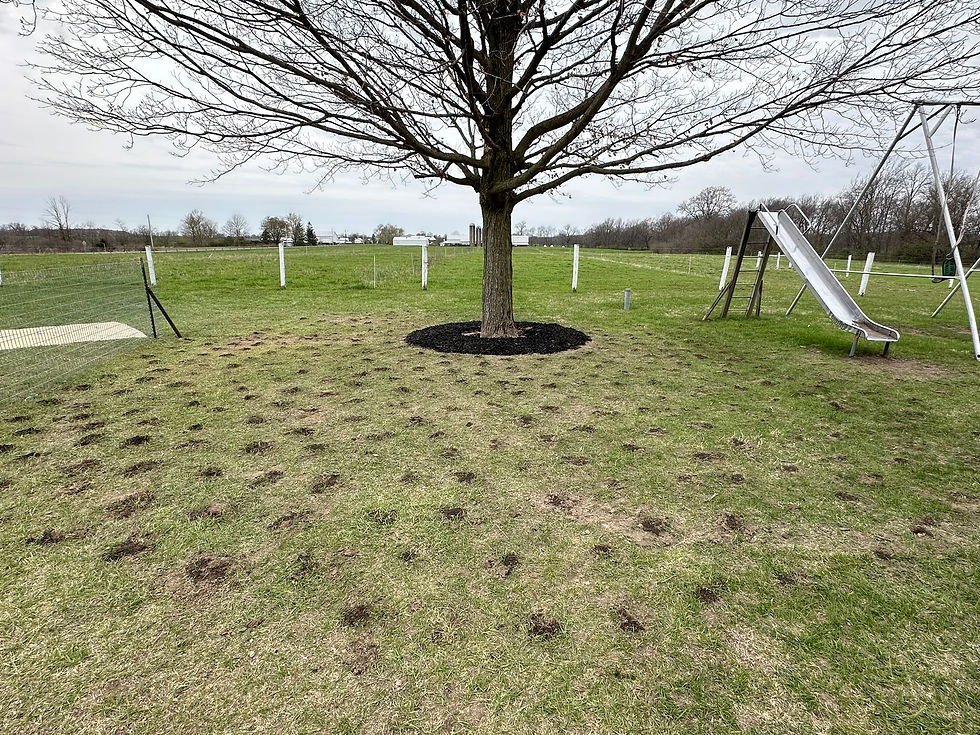
Afterword
I had the privilege of being invited to attend a school recital exactly two weeks after I did the work on the boys’ tree. As I drove up to the school house, I was surprised to see the tree had leafed out well ahead of the girls’ tree. When I found Michael, I immediately asked him if this was normal. He said that actually, in the last five years or so, the boys’ tree had leafed out later than the girls’ tree, consistent with a tree falling into decline. He said he was amazed when he saw the boys’ tree begin to leaf out just a few days after I had finished my work. Below is a photo taken on the day of the school recital, with permission granted. Notice how the leaf expansion on the boys’ tree (on left) is more advanced than on the girls’ tree.

I had done the same type of work to a street tree in Marysville, Ohio, about a week prior. In this case the trees were silver linden. I drove past the site last week and took the following photo from my truck. The nearest tree is the one I worked on. The two trees further to the left I pruned some girdling roots off, but did not do any root zone invigoration work. The difference is clearly visible!

I loved reading this. So very interesting and informative. Can’t wait for the next one. Also, our magnolia tree leafed out and so far no sign of magnolia scale.
Great read. Please keep them coming!